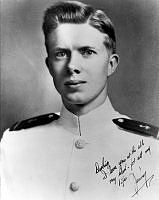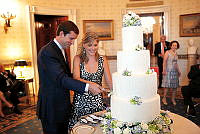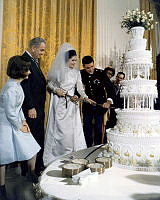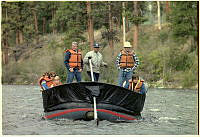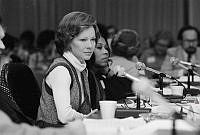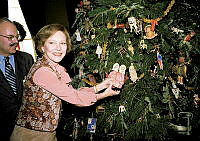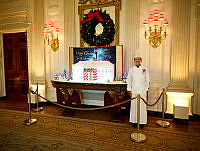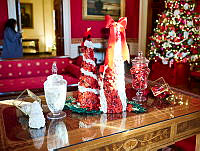Florence Harding
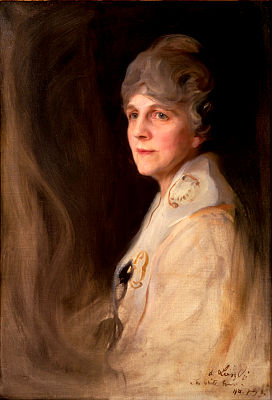
On August 15, 1860, Florence Mabel Kling was born in Marion, Ohio, to parents Louisa Bouton Kling and Amos Kling. Kling’s success as a businessman allowed Florence and her brothers to enjoy a comfortable upbringing. Florence had an extensive education and a talent for piano, which culminated in her enrollment at the Cincinnati Conservatory of Music. Afterward, Florence worked as a piano teacher in Marion.1 In 1880, she gave birth to a son named Marshall; the boy’s father was neighbor Henry de Wolf.2 The details about their relationship, which may have been an elopement or a common-law marriage, are unclear, but the two divorced in 1886.3 After their separation, Amos Kling adopted and raised his grandson, and Marshall and Florence had a strained relationship throughout his life.
In 1891, despite her father’s disapproval, Florence fell in love with Warren G. Harding, owner of the Marion Star newspaper.4 They were married on July 8, 1891.5 She helped Harding manage the Marion Star, serving as a partner and advisor to him in decisions throughout his life, including his career in politics. She was politically inclined herself, becoming a staunch supporter of women’s suffrage and a member of the League of Women Voters and the National Woman's Party.6 In fact, Florence Harding was the first future first lady to vote in a presidential election, following ratification of the Nineteenth Amendment.7
When the Hardings moved into the White House in 1921, she proved to be a modern, active first lady. Understanding the importance of visibility and accessibility for a first family, she reopened the White House and its grounds to the public for the first time since World War I, and regularly hosted receptions and photo opportunities for visitors and interest groups.8 She invited jazz musicians and celebrities to the Executive Mansion, adding a sense of modernity and style to the presidency. Moreover, Florence Harding used her platform as first lady to advocate for animal rights, veterans’ welfare, and women’s equality.9
As first lady, Florence Harding juggled chronic kidney disease and President Harding’s scandals.10 Nevertheless, she was an important political partner to the president, advising him on speeches, policies, and federal appointments. As one newspaper wrote: “Not until some woman is elected president of the United States in her own right will the White House know again so keen a female politician as Mrs. Florence Kling Harding.”11
Unfortunately, her tenure as first lady ended unexpectedly. President Harding died of a heart attack in summer 1923; he and Mrs. Harding had been on a trip through the Western United States and territory of Alaska, often called Harding’s “Voyage of Understanding.”12 After his death, Florence traveled cross country via funeral train to Washington, D.C. There, President Harding’s body lay in state in the Capitol Building following a viewing at the White House.13 Following Harding’s death, Florence’s own health declined, and she returned to Ohio to recover. She died of kidney failure on November 21, 1924.14 She and President Harding are buried at the Harding Memorial in Marion, Ohio.
Footnotes & Resources
- “Florence Harding,” Warren G. Harding Presidential Sites, https://hardingpresidentialsites.org/florence-harding/.
- “Marshall Eugene DeWolfe,” Ancestry.com. U.S., Find a Grave Index, 1600s-Current [database on-line]. Lehi, UT, USA: Ancestry.com Operations, Inc., 2012.
- “Divorce Decree,” 1886, in Florence K. Harding Diary, Correspondence, and Financial Records Collection, OhioLink.
- Eugene P. Trani, “Warren G. Harding: Life Before the Presidency,” Miller Center, https://millercenter.org/president/harding/life-before-the-presidency.
- “Florence Harding,” Warren G. Harding Presidential Sites, https://hardingpresidentialsites.org/florence-harding/.
- “Florence Harding,” Miller Center, https://millercenter.org/president/harding/essays/harding-1921-firstlady.
- See Warren Harding Photograph Collection in Ohio History Collection, https://ohiomemory.org/digital/collection/p16007coll100/id/568/.
- Carl Sferrazza Anthony, Florence Harding: The First Lady, the Jazz Age, and the Death of America’s Most Scandalous President (New York: William Morrow and Co., 1998).
- Ibid.
- The Teapot Dome Scandal, which implicated Harding and his cabinet in government corruption, forever tarnished Harding’s presidential legacy.
- Robert T. Small, “Mrs. Harding Was Keen Politician and Aid to Her Husband,” The Evening Tribune, November 21, 1924.
- “President Harding’s Voyage of Understanding,” White House Historical Association, https://www.whitehousehistory.org/digital-library/exhibits/president-hardings-voyage-of-understanding.
- “Warren G. Harding Funeral,” White House Historical Association, https://www.whitehousehistory.....
- “Florence Harding,” Harding Presidential Sites, https://hardingpresidentialsites.org/florence-harding/.














